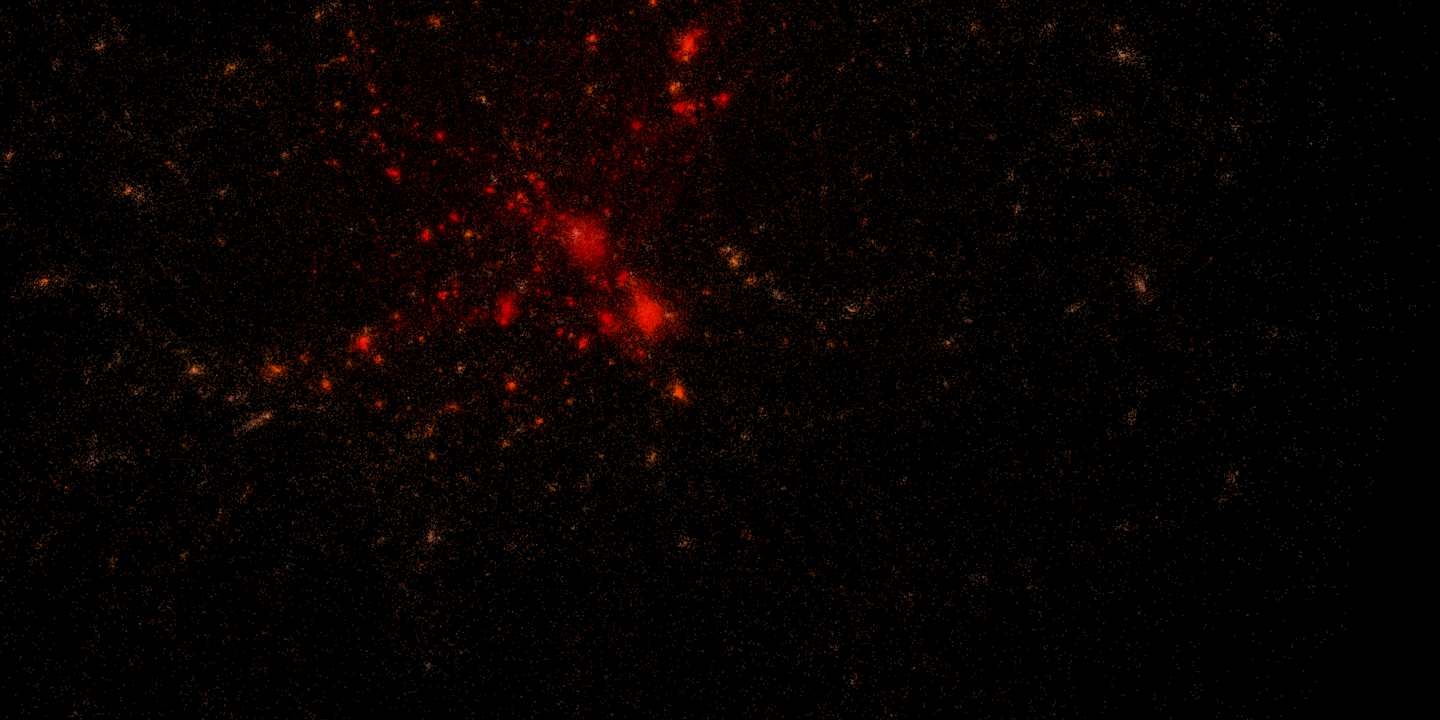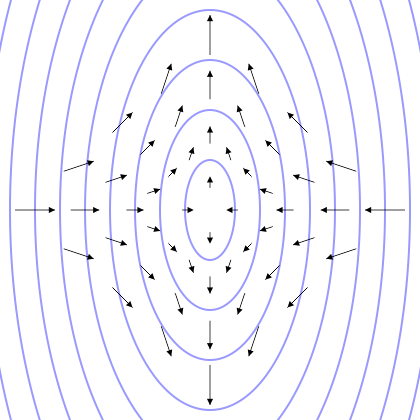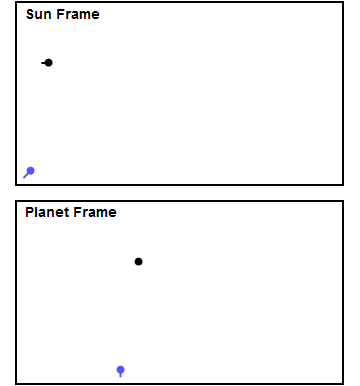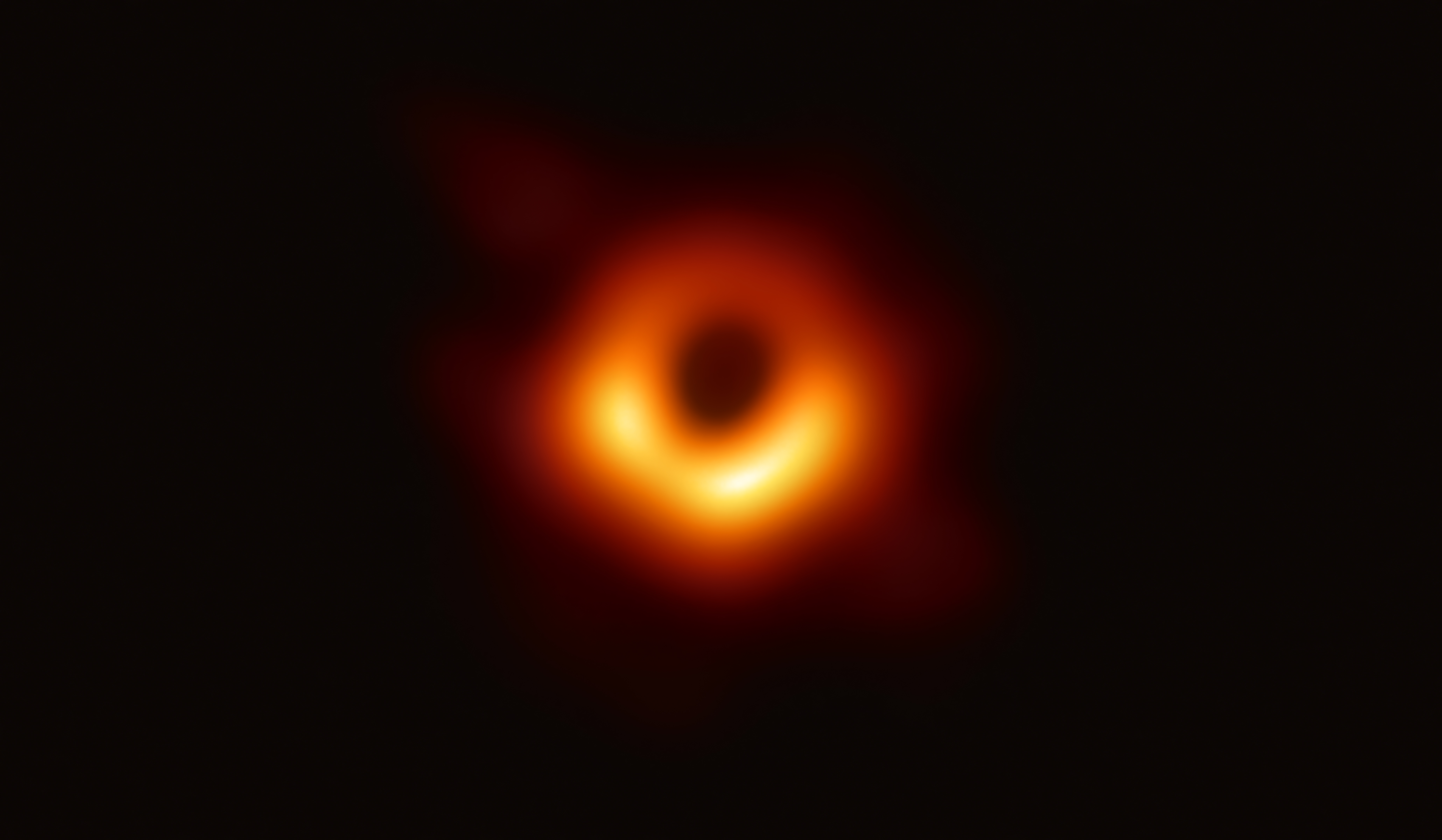|
Rotational Brownian Motion (astronomy)
In astronomy, rotational Brownian motion is the random walk in orientation of a binary star's orbital plane, induced by gravitational perturbations from passing stars. Theory Consider a binary that consists of two massive objects (stars, black holes etc.) and that is embedded in a stellar system containing a large number of stars. Let M_1 and M_2 be the masses of the two components of the binary whose total mass is M_=M_1+M_2. A field star that approaches the binary with impact parameter p and velocity V passes a distance r_p from the binary, where p^2=r_p^2\left(1+2GM_/V^2r_p\right) \approx 2GM_r_p/V^2; the latter expression is valid in the limit that gravitational focusing dominates the encounter rate. The rate of encounters with stars that interact strongly with the binary, i.e. that satisfy r_p < a, is approximately where and are the number density and velocity dispersion of the ... [...More Info...] [...Related Items...] OR: [Wikipedia] [Google] [Baidu] |
Random Walk
In mathematics, a random walk, sometimes known as a drunkard's walk, is a stochastic process that describes a path that consists of a succession of random steps on some Space (mathematics), mathematical space. An elementary example of a random walk is the random walk on the integer number line \mathbb Z which starts at 0, and at each step moves +1 or −1 with equal probability. Other examples include the path traced by a molecule as it travels in a liquid or a gas (see Brownian motion), the search path of a foraging animal, or the price of a fluctuating random walk hypothesis, stock and the financial status of a gambler. Random walks have applications to engineering and many scientific fields including ecology, psychology, computer science, physics, chemistry, biology, economics, and sociology. The term ''random walk'' was first introduced by Karl Pearson in 1905. Realizations of random walks can be obtained by Monte Carlo Simulation, Monte Carlo simulation. Lattice random ... [...More Info...] [...Related Items...] OR: [Wikipedia] [Google] [Baidu] |
N-body Simulation
In physics and astronomy, an ''N''-body simulation is a simulation of a dynamical system of particles, usually under the influence of physical forces, such as gravity (see n-body problem, ''n''-body problem for other applications). ''N''-body simulations are widely used tools in astrophysics, from investigating the dynamics of few-body systems like the Earth-Moon-Sun system to understanding the evolution of the large-scale structure of the universe. In physical cosmology, ''N''-body simulations are used to study processes of non-linear structure formation such as galaxy filaments and galaxy halos from the influence of dark matter. Direct ''N''-body simulations are used to study the dynamical evolution of star clusters. Nature of the particles The 'particles' treated by the simulation may or may not correspond to physical objects which are particulate in nature. For example, an N-body simulation of a star cluster might have a particle per star, so each particle has some physic ... [...More Info...] [...Related Items...] OR: [Wikipedia] [Google] [Baidu] |
Astrophysics
Astrophysics is a science that employs the methods and principles of physics and chemistry in the study of astronomical objects and phenomena. As one of the founders of the discipline, James Keeler, said, astrophysics "seeks to ascertain the nature of the heavenly bodies, rather than their positions or motions in space—''what'' they are, rather than ''where'' they are", which is studied in celestial mechanics. Among the subjects studied are the Sun ( solar physics), other stars, galaxies, extrasolar planets, the interstellar medium, and the cosmic microwave background. Emissions from these objects are examined across all parts of the electromagnetic spectrum, and the properties examined include luminosity, density, temperature, and chemical composition. Because astrophysics is a very broad subject, ''astrophysicists'' apply concepts and methods from many disciplines of physics, including classical mechanics, electromagnetism, statistical mechanics, thermodynamics, quantum ... [...More Info...] [...Related Items...] OR: [Wikipedia] [Google] [Baidu] |
Gravitational Wave
Gravitational waves are oscillations of the gravitational field that Wave propagation, travel through space at the speed of light; they are generated by the relative motion of gravity, gravitating masses. They were proposed by Oliver Heaviside in 1893 and then later by Henri Poincaré in 1905 as the gravitational equivalent of Electromagnetic radiation, electromagnetic waves. In 1916, Albert Einstein demonstrated that gravitational waves result from his general theory of relativity as ripples in spacetime. Gravitational waves transport energy as gravitational radiation, a form of radiant energy similar to electromagnetic radiation. Newton's law of universal gravitation, part of classical mechanics, does not provide for their existence, instead asserting that gravity has instantaneous effect everywhere. Gravitational waves therefore stand as an important relativistic phenomenon that is absent from Newtonian physics. Gravitational-wave astronomy has the advantage that, unlike elec ... [...More Info...] [...Related Items...] OR: [Wikipedia] [Google] [Baidu] |
Gravitational Slingshot
A gravity assist, gravity assist maneuver, swing-by, or generally a gravitational slingshot in orbital mechanics, is a type of spaceflight flyby which makes use of the relative movement (e.g. orbit around the Sun) and gravity of a planet or other astronomical object to alter the path and speed of a spacecraft, typically to save propellant and reduce expense. Gravity assistance can be used to accelerate a spacecraft, that is, to increase or decrease its speed or redirect its path. The "assist" is provided by the motion of the gravitating body as it pulls on the spacecraft. Any gain or loss of kinetic energy and linear momentum by a passing spacecraft is correspondingly lost or gained by the gravitational body, in accordance with Newton's Third Law. The gravity assist maneuver was first used in 1959 when the Soviet probe Luna 3 photographed the far side of Earth's Moon, and it was used by interplanetary probes from Mariner 10 onward, including the two Voyager probes' no ... [...More Info...] [...Related Items...] OR: [Wikipedia] [Google] [Baidu] |
Dynamical Friction
In astrophysics, dynamical friction or Chandrasekhar friction, sometimes called gravitational drag, is loss of momentum and kinetic energy of moving bodies through gravitational interactions with surrounding matter in space. It was first discussed in detail by Subrahmanyan Chandrasekhar in 1943. Intuitive account An intuition for the effect can be obtained by thinking of a massive object moving through a cloud of smaller lighter bodies. The effect of gravity causes the light bodies to accelerate and gain momentum and kinetic energy (see slingshot effect). By conservation of energy and momentum, we may conclude that the heavier body will be slowed by an amount to compensate. Since there is a loss of momentum and kinetic energy for the body under consideration, the effect is called ''dynamical friction''. Another equivalent way of thinking about this process is that as a large object moves through a cloud of smaller objects, the gravitational effect of the larger object pulls ... [...More Info...] [...Related Items...] OR: [Wikipedia] [Google] [Baidu] |
Monthly Notices Of The Royal Astronomical Society
''Monthly Notices of the Royal Astronomical Society'' (MNRAS) is a peer-reviewed scientific journal in astronomy, astrophysics and related fields. It publishes original research in two formats: papers (of any length) and letters (limited to five pages). MNRAS publishes more articles per year than any other astronomy journal. The learned society journal has been in continuous existence since 1827 and became online only in 2020. It operates as a partnership between the Royal Astronomical Society (RAS), who select and peer-review the contents, and Oxford University Press (OUP), who publish and market the journal. Despite its name, MNRAS is no longer monthly, nor does it carry the notices of the RAS. In 2024 MNRAS became a purely gold open access journal. History The first issue of MNRAS was published on 9 February 1827 as ''Monthly Notices of the Astronomical Society of London'' and it has been in continuous publication ever since. It took its current name from the second vo ... [...More Info...] [...Related Items...] OR: [Wikipedia] [Google] [Baidu] |
Galaxies
A galaxy is a system of stars, stellar remnants, interstellar gas, dust, and dark matter bound together by gravity. The word is derived from the Greek ' (), literally 'milky', a reference to the Milky Way galaxy that contains the Solar System. Galaxies, averaging an estimated 100 million stars, range in size from dwarfs with less than a thousand stars, to the largest galaxies known – supergiants with one hundred trillion stars, each orbiting its galaxy's centre of mass. Most of the mass in a typical galaxy is in the form of dark matter, with only a few per cent of that mass visible in the form of stars and nebulae. Supermassive black holes are a common feature at the centres of galaxies. Galaxies are categorised according to their visual morphology as elliptical, spiral, or irregular. The Milky Way is an example of a spiral galaxy. It is estimated that there are between 200 billion () to 2 trillion galaxies in the observable universe. Most galaxies are 1,000 to 10 ... [...More Info...] [...Related Items...] OR: [Wikipedia] [Google] [Baidu] |
David Merritt
David Roy Merritt (born November 16, 1955, in Los Angeles) is an American astrophysicist. He is known for Osipkov–Merritt model, the Leonard–Merritt mass estimator and the M–sigma relation. Education and career He received in 1982 his PhD in Astrophysical Sciences from Princeton University with thesis advisor Jeremiah P. Ostriker and held postdoctoral positions at the University of California, Berkeley and the Canadian Institute for Theoretical Astrophysics in Toronto. Merritt's fields of specialization include dynamics and evolution of galaxies, supermassive black holes, and computational astrophysics. Until 2017, he was a professor at the Rochester Institute of Technology (RIT) in Rochester, New York. He was a former Chair of the Division on Dynamical Astronomy of the American Astronomical Society. He is a founding member of the Center for Computational Relativity and Gravitation at RIT. His scientific contributions include Osipkov–Merritt models, bl ... [...More Info...] [...Related Items...] OR: [Wikipedia] [Google] [Baidu] |
Binary Star
A binary star or binary star system is a system of two stars that are gravitationally bound to and in orbit around each other. Binary stars in the night sky that are seen as a single object to the naked eye are often resolved as separate stars using a telescope, in which case they are called ''visual binaries''. Many visual binaries have long orbital periods of several centuries or millennia and therefore have orbits which are uncertain or poorly known. They may also be detected by indirect techniques, such as spectroscopy (''spectroscopic binaries'') or astrometry (''astrometric binaries''). If a binary star happens to orbit in a plane along our line of sight, its components will eclipse and transit each other; these pairs are called ''eclipsing binaries'', or, together with other binaries that change brightness as they orbit, ''photometric binaries''. If components in binary star systems are close enough, they can gravitationally distort each other's outer stellar atmospheres. ... [...More Info...] [...Related Items...] OR: [Wikipedia] [Google] [Baidu] |
Supermassive Black Hole
A supermassive black hole (SMBH or sometimes SBH) is the largest type of black hole, with its mass being on the order of hundreds of thousands, or millions to billions, of times the mass of the Sun (). Black holes are a class of astronomical objects that have undergone gravitational collapse, leaving behind spheroidal regions of space from which nothing can escape, including light. Observational evidence indicates that almost every large galaxy has a supermassive black hole at its center. For example, the Milky Way galaxy has a supermassive black hole at its center, corresponding to the radio source Sagittarius A*. Accretion of interstellar gas onto supermassive black holes is the process responsible for powering active galactic nuclei (AGNs) and quasars. Two supermassive black holes have been directly imaged by the Event Horizon Telescope: the black hole in the giant elliptical galaxy Messier 87 and the black hole at the Milky Way's center (Sagittarius A*). Descr ... [...More Info...] [...Related Items...] OR: [Wikipedia] [Google] [Baidu] |
Reduced Mass
In physics, reduced mass is a measure of the effective inertial mass of a system with two or more particles when the particles are interacting with each other. Reduced mass allows the two-body problem to be solved as if it were a one-body problem. Note, however, that the mass determining the gravitational force is ''not'' reduced. In the computation, one mass ''can'' be replaced with the reduced mass, if this is compensated by replacing the other mass with the sum of both masses. The reduced mass is frequently denoted by \mu ( mu), although the standard gravitational parameter is also denoted by \mu (as are a number of other physical quantities). It has the dimensions of mass, and SI unit kg. Reduced mass is particularly useful in classical mechanics. Equation Given two bodies, one with mass ''m''1 and the other with mass ''m''2, the equivalent one-body problem, with the position of one body with respect to the other as the unknown, is that of a single body of mass \m ... [...More Info...] [...Related Items...] OR: [Wikipedia] [Google] [Baidu] |






